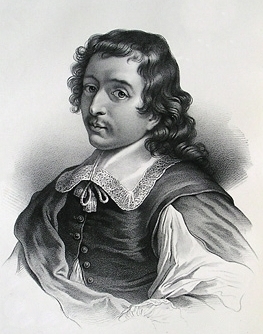
November 19, 1616, the famous French painter Eustace Lesuer was born. The son of a woodcarver, he entered the workshop of the famous court painter Simon Vou at the age of 16. The master highly valued the talented student, and in the 1630s entrusted him with a large order – 8 paintings on scenes from the poem of the Venetian author of the 15th century “Polifil’s Dreams”, which were later performed in trellises. This was the beginning of the artist’s great creative career.
Worked as an artist in the genre of portrait. His paintings are characterized by a rich color palette and airiness, ease of drawing, the ability to convey the individuality of their models. In the paintings of Lesuyer felt imitation of the great master of the Renaissance Rafael Santi. Light coloring, restraint poses, pictures of Lesuer’s brush on the gospel stories are full of contemplative tranquility, they do not have the baroque heat of passion and pretentiousness.
Female images of the artist, appearing in pictures on mythological subjects, are full of sensuality and sophistication. The elegant pose of the goddess of love on the canvas “Sleeping Venus and Cupid” and effective chiaroscuro after two centuries, creating its odalisks, repeated Ingres, who admired the painting of Lesuer.
Since 1648, Estás Lesuer – a recognized master, he fulfills orders for the royal court, rich monasteries, cathedrals and even for the king’s apartments in the Louvre. Decorative and refined painting Liseruer allowed him to become an outstanding interior decorator, in the French school of painting, this activity was not only particularly profitable, but always took an honorable place.
But the fate of most of the artist’s works, unfortunately, is sad. Most of the decorative panels are not preserved, and the few remaining are scattered and stored in the museum’s storerooms, many of the pictures are known only from engravings made from them or even from references in documents. Therefore, this great master of French painting is not widely known.
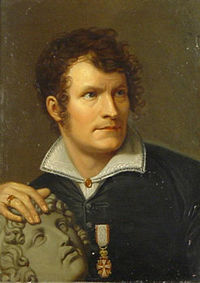
The son of the woodcarver Bertel Thorvaldsen was born in Copenhagen in 1770. Father managed to instill in the boy a love of art, and already in 1781 Thorvaldsen became a student of the Royal Academy of Arts in Copenhagen.
His main mentor was the famous Danish sculptor Widevelt. In 1793, Thorvaldsen received the Great Gold Medal for relief “Peter heals the lame,” and with it – the right of pensionership in Italy, and in 1796 Thorvaldsen went to Rome.
In Italy, Thorvaldsen will spend most of his life, about forty years. For all the love of the works of ancient sculptors, for example Phidias or Praxiteles, Thorvaldsen, however, did not become their blind imitator. Antique art was for Torvaldsens the source of inspiration, in his creative way he always remained highly individual, true to his peculiar genius, equally strong in the statue and in the field of relief.
The sculptor worked in the genre of portrait. In general, these are monuments-monuments: Copernicus for Krakow Cathedral, Schiller in Stuttgart, Byron in Cambridge. In 1818, Thorvaldsen created a sculptural portrait of Maria Fedorovna Baryatinskaya, the wife of the famous Russian diplomat II Baryatinsky.
In 1820, Thorvaldsen was commissioned the sculptural decoration of the main cathedral of Copenhagen – the Cathedral of Our Lady. The artist creates an ensemble, which includes the twelve figures of the apostles, placed along the walls of the central nave of the cathedral, the figure of Christ in the apse.
Thorvaldsen died suddenly in Copenhagen on March 24, 1844, attending an evening performance at the Royal Theater. Before his death, the great sculptor bequeathed all his works to the city.
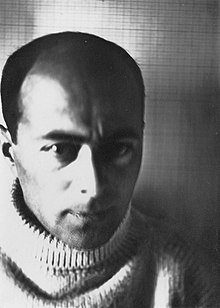
Lazar Markovich Lisitsky, widely known as El Lisitsky, was born on November 22, 1890 in the village of Pochinok, Smolensk province. The artist successfully graduated from the Higher Polytechnic School in Germany, having received the diploma of an engineer-architect, traveled a lot around Europe, however, the First World War that had begun caused Lisitsky to hurry back to his homeland.
Working as an assistant in the architectural bureau, Lisitsky begins to paint and illustrate. Working in the Jewish Society for the Encouragement of the Arts, he makes out the works of Jewish authors. In the same year 1916 Lisitsky joins the ethnographic expedition, which studies the monuments of Jewish antiquity in Belorussian Dnieper and Lithuania. Following the results of this expedition, he publishes a theoretical work on the Jewish decorative arts “Memories of the Mogilev Synagogue.”
At the invitation of M.Z. Chagall in 1919, Lisitsky moved to Vitebsk. At this time the artist is fond of non-objective creativity, teaches at the National Art School. It was at this time that Lisitsky received the pseudonym “El Lisitsky”. The artist makes out the city on holidays, participates in the preparation of the celebrations of the Committee to Combat Unemployment. He continues to work on the design of books and posters.
In 1921-1925 he lived in Germany and Switzerland; joined the Dutch group “Style”. Since the late 1920s El Lisitsky lives in Moscow, creates campaign posters, designs furniture, takes a great interest in photography and photomontage. In 1930-1932, according to the project of El Lisitsky, the printing house of the magazine Ogonyok was built.
The painter died of tuberculosis on December 30, 1941 in Moscow, was buried in the Don Cemetery.
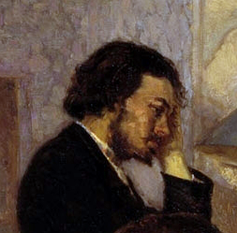
165 years is the birthday of the Russian artist Alexei Fedorovich Afanasyev. He was born in the family of a servant of the Highest Imperial Court, and at the age of 18 he also began work at the court, first a stoker, and then a footman. However, in 1872 Afanasiev entered the Academy of Arts as a volunteer, where he would study until 1880.
In 1886, Afanasiev took the certificate of visiting the Academy classes in the Academy and the following year he began to work as a teacher in the Drawing School of the Society for the Encouragement of Arts. The artist continued to engage in his own creativity, working primarily in the domestic genre.
At the end of the 1880s, Afanasyev joined the “Association of Traveling Art Exhibitions”, at the exhibitions of the 1876 and 1890s, he presented his genre paintings “Cemetery” and “Before the Feast”.
Along with other painters, Alexei Afanasyev participated in the design of the Cathedral of the Resurrection of Christ in St. Petersburg, which is also called the Church of the Savior on the Spilled Blood, since it was erected on the site where on March 1, 1881, as a result of the attempt, the Emperor Alexander II was mortally wounded. From 1894 to 1897, according to the artist’s sketches, four exterior mosaics were created in the kokoshniks of the temple and eight mosaics for the interior.
But Alexei Afanasyev is best known not as a painter, but as an illustrator and cartoonist. He worked fruitfully for many years with the magazines Shut, The Shards, Lukomorye, and others. In 1897-1898, in the magazine Shut, Ershov’s fairy-tale “The Little Humpbacked Horse” was printed, illustrated by Aleksey Afanasyev.

Alexei von Yawlensky is a Russian expressionist artist, most of whose work was created in Germany.
In 1896, the pupil of Ilya Repin Alexei Yavlensky moved to Munich, where together with Vasily Kandinsky entered the art studio of Anton Azhbe.
The style of Yavlensky constantly evolved, for example, for some time he created in the style of Van Gogh. Then, under the influence of French artists, Jawlensky developed his own artistic strategy.
Yavlensky was a member of such associations as the “new Munich Art Association”, “Blue Rider”, “The Blue Four”, which organized exhibitions of artists in Germany and the United States.
Since 1927, the artist began to suffer from arthritis. Over time, in order to continue drawing, Yavlensky began to tie the brush to his hands. It was during this period that a series of “Meditations” appeared, which became the pinnacle of the artist’s work. One of the objects of interest to the artist for study has always been a human face. In the cycle of “Meditation” Jawlensky for the image of the person turns to abstraction.
In 1937, about seventy works of the artist were confiscated by the Nazis as “degenerate art.”
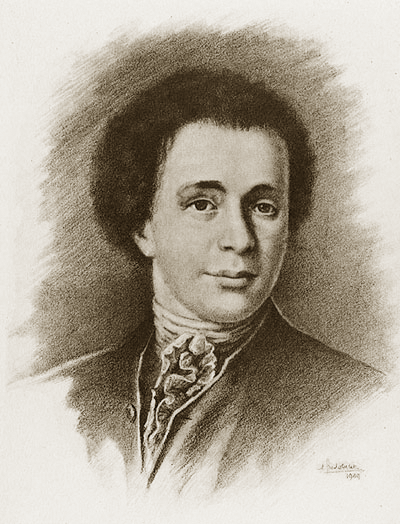
“It is difficult to find a more perfect balance of all parts of a single structure than that achieved here,” Igor Grabar wrote about Pashkov’s house in Moscow. This palace is located opposite the Moscow Kremlin-now this is the old building of the library of the former Rumyantsev Museum. Uneven plot in many ways complicated the task of the architect, but Vasily Bazhenov was able to create an amazingly refined and harmonious building, which became the decoration of Moscow.
Vasily Bazhenov was born in the Kaluga province, but soon after the birth of his son, the family moved to the capital. The love of drawing, perseverance and diligence enabled the son of the church sexton to achieve incredible successes, to obtain a noble title, to leave a mark on the history of architecture.
Not even reaching the age of 18, Vasily Bazhenov earned the rank of second-class painter. The young man’s talent was noticed by the architect Ukhtomsky, who in 1751 enlisted Bazhenov as an auditor in his own architectural school. Already in 1757 Bazhenov entered the Academy of Arts, where his teacher becomes Chevakinsky. The venerable architect appreciated Bazhenov’s work and appointed him as his assistant during the construction of the St. Nicholas Naval Cathedral. In 1759, one of the first Vasily Bazhenov was sent by the Academy to France, where he continued studying architecture under the leadership of Devalia.
Despite the fact that Vasily Bazhenov had a brilliant education, had a talent, many of his projects were not implemented. For eight years, the architect was developing the concept of the Grand Kremlin Palace, however, the construction of the grandiose complex was never completed. Ten years he spent on the erection of the royal residence in Tsaritsyno, but the pseudo-gothic buildings seemed dark to Catherine II, and as a result all the central buildings were demolished and rebuilt by the architect Kazakov.
After the death of the empress, Paul I, who ascended the throne, returns the architect from disgrace: he not only appoints him to the post of vice-president of the Academy of Arts, but instructs Bazhenov to conduct a study of Russian architects’ projects and to supervise the most talented. These plans architect was not destined to come true – in August 1799, Vasily Bazhenov died.
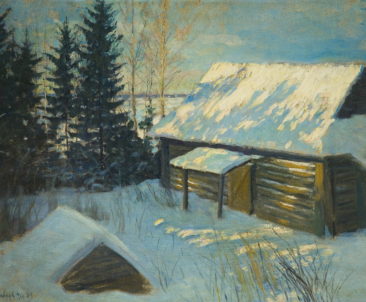
Igor Grabar was born in Budapest in the family of the Russian public figure Emmanuel Grabar. Shortly after the birth of his son, his father and his family were forced to flee Hungary to Italy, and in 1876 his parents, who were among the supporters of the Slavic liberation movement, moved to Russia.
From 1882 to 1989 Grabar studied at the Moscow Lyceum, and from 1889 to 1895 at the St. Petersburg University at once in two faculties – law and history and philology. However, unlike Vladimir’s older brother, who became a famous lawyer, Igor preferred the artist’s career. Even in Moscow, he attended classes in drawing the Moscow Society of Art Lovers and in 1894 entered the Academy of Arts.
The summer of 1895 during the holidays, Grabar travels through Europe, studying the works of old masters. This trip has so captivated the artist that he decides to stay in Europe. However, returning in 1901 to Russia, Igor Grabar was again shocked by the beauty of Russian nature.
In 1910-1923, he moved away from painting and was carried away by architecture, art history, museum activities, the protection of monuments. He conceives and implements the publication of the first “History of Russian Art” in six volumes, writes for it the most important sections, publishes monographs on Valentin Serov and Isaak Levitan. In 1937 he created a two-volume monograph “Repin”. This work brought Grabar Stalin Prize.
Between 1913 and 1925, the artist headed the Tretyakov Gallery. Igor Emmanuilovich is one of the founders of museology, restoration work and protection of monuments of art and antiquity. In 1918 the artist created the Central Restoration Workshop. He helped to save many works of ancient Russian art.
From 1924 to the end of the 1940s Grabar again returned to painting, in the Voronezh Art Museum. I. Kramskoy presents the work of this period – “Winter Day”, 1939. Igor Grabar can truly be considered a singer of Russian winter. In his works, with great love and skill, a radiant whiteness of snow, a special transparent, crystal clear air was transmitted. Snowdrifts shimmer in the sun with all the colors of the rainbow, Valentin Serov noted the skill of Grabar with the words: “It’s a difficult task, but left you,” he told him. “Winter is really white, but you do not feel white.”
Igor Grabar died on May 16, 1960. He was buried in Moscow at the Novodevichy Cemetery.
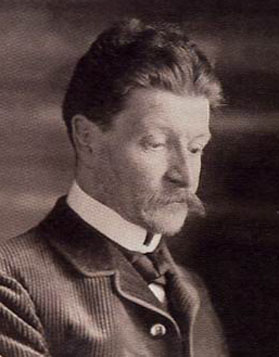
At the end of the XIX century, the artistic culture of Russia experienced a period of formation of a new style, which in Russia was called “modern”. The language of painting in this style acquired pronounced decorative features, a solid linear-structural basis. Ancestor, one of the brightest representatives of this style in Russia can be considered Mikhail Vrubel.
The future artist was born in Omsk, in the family of military lawyer Alexander Vrubel. Father wanted a reliable and prosperous future for his son, so Mikhail entered the law faculty of St. Petersburg University. However, the craving for art was so strong that Mikhail Vrubel began to attend the evening class of Pavel Chistyakov at the Academy of Arts.
Vrubel’s picturesque manner is easily recognizable – it’s a kind of crystal pattern shimmering with lilac-purple tones. This special style was formed in the Kiev years, when Mikhail Vrubel was invited to restore the Church of St. Cyril. Following this monumental experience, the second one was to follow, and the construction of the Vladimir Cathedral was over in Kiev, and the artist began working on the sketches of the paintings, but they turned out so unusual that the customers refused to cooperate. The only thing that Vrubel’s sketches were made of were designs of his ornaments that were extremely typical of the Art Nouveau style – they were made up of bent lines, interwoven plant stems and scattered spangles of peacock feathers.
From 1889 to 1902, Vrubel creativity was experiencing the highest flowering, the time of its maturity. It was in the 1890s that the artist’s universalism manifested itself. Striving to implement in a variety of undertakings, Vrubel, in addition to writing the paintings, created a number of monumental paintings, performed theater decorations, engaged in graphics, sculpture, tried himself as an architect. At the same time, the theme of the Demon, who accompanied Vrubel almost all his life, was realized.
In 1902, the artist showed signs of mental disorder. In 1903, Vrubel’s two-year-old son died, and his mind finally broke. The disease then progressed, then retreated, but even being in the clinic, the artist did not stop drawing. In 1906 another misfortune – Vrubel went blind. In this condition he was destined to live another 4 years.
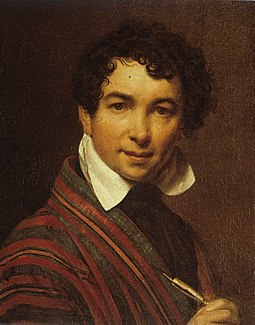
The life of Orest Kiprensky is full of mysteries and mysteries. The illegitimate son of the landowner Dyakonov was brought up in the family of the serf Adam Schwalbe. In 1788 he was enrolled in the Educational School at the Academy of Arts. Despite the fact that the artist was trained in the class of historical painting, his talent more fully revealed in the genre of the portrait. He became not only the leading portraitist of his time, but also an unrivaled master of romantic painting.
The portrait of Alexander Sergeevich Pushkin, commissioned by Anton Delvig in 1827, is probably the artist’s most famous work. Reproductions from her adorn the study rooms in many schools of the country. Of the numerous portraits of the great Russian poet, this picture is highlighted by some romantic generalized image. Pushkin is depicted in three quarters to the viewer, his view is thoughtful and sad, the poet is immersed in reflections, the entire canvas is imbued with spirituality.
However, Kiprensky considered his true vocation historical painting, he wrote portraits mainly for the sake of earnings. As soon as peace came in Europe, Kiprensky went to Italy with the intention of writing a significant historical painting that would bring him fame and fame. The painting “Anacreon’s Tomb” had no success.
The artist returned to Petersburg in 1823 and was very coldly received. The reason for this was two mysterious stories, firstly, in Italy, a model posing for Kiprensky was killed, and secondly, he took under the protection of a ten-year-old girl Mariucci, to whom he was extremely attached. Hard work and talented work returned the Kiprensky favor of the upper world. In 1828, the artist returned to Italy, where he lived until the end of his days. He married Mariucche in 1836, but the happiness was short-lived – four months after the wedding, the painter died.
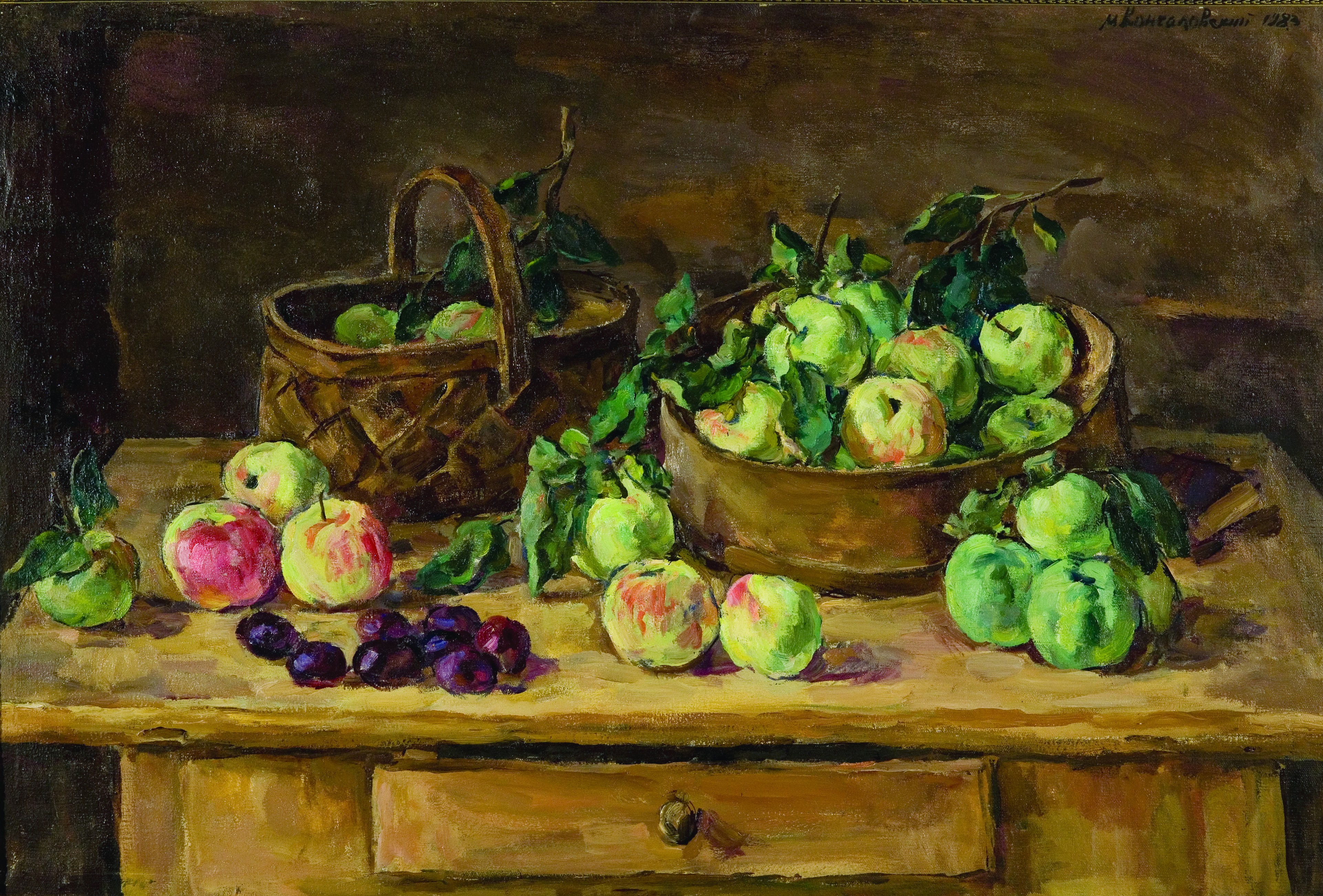
Konchalovsky Mikhail Petrovich was born on March 29, 1906 in the family of the famous Russian artist Petr Konchalovsky. The boy grew up in a special creative environment, his mother Olga Konchalovskaya was the daughter of Vasily Surikov himself, and he often stayed in the house of his daughter and son-in-law.
Mikhail Konchalovsky worked in a realistic manner, however his painting is far from being a socialist realism, popular and supported by the authorities. The artist preferred to paint still lifes, landscapes and portraits full of lyricism and love of life. His still lifes echo with the still lives of small Dutch people – they are just as naturalistic and appetizing. A wonderful colorist, Mikhail Konchalovsky did not immediately come to painting, his first oil sketches were created in Venice, while traveling with his father. In 1924 – 1930 years. Mikhail Konchalovsky studied at VKhUTEIN in the workshops of Osmorkin and Mashkov, Mashkov’s influence was especially noticeable in Konchalovsky’s early works.
Mikhail Konchalovsky worked a lot with his father during joint trips to Novgorod (1926-1928), to the Caucasus (1927,1931), to the Crimea (1929), Murmansk (1936), Krasnoyarsk (1951). He created a series of works “Monuments of Russian Architecture”.
In the Voronezh Regional Museum. Kramskoy kept two still lifes of Mikhail Konchalovsky’s brush – “Game” and “Apples and Plums”. Despite the fact that these works are divided two decades, they are similar in their execution. His paintings are juicy, bright, expressive, rich in color, in all his strength and subtlety, the canvases seem to be filled with life and light.